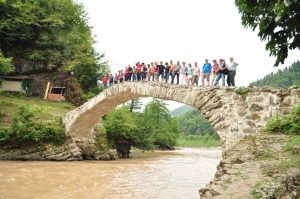Sabine Dues shares her experiences on a best practice model in collaborations
At Forschungszentrum Jülich, one of our coolest collaboration models is the Science Bridge model, a two-way walkway to connect people and knowledge to achieve great scientific results and to attract the best talents.
Collaboration means working together. In international collaborations, however, scientists work together which usually have different cultural backgrounds as they come from different countries of origin. Everyone knows how fast it comes because of cultural differences that communication leads to misunderstandings and thus problems within the collaboration: the project is delayed; people are stressed, upset or become indignant. This definitely does not help to push a project forward, and everyone has once wondered in a project why the partner acted as did because the tasks were clearly outlined and the responsibilities were well defined in advance. As part of our Science Bridge collaboration model, we focus on cultural differences and the achievement of scientific results right from the start. We build a “bridge”, a two-way walkway to connect people and knowledge from both sides at the same time.
Make people work togehter

Georgian-German Science Bridge (GGSB) Meeting in Batumi, Georgia; Bridge of Queen of Tamar (12th Century) in Mahuntseti, Keda; Source: Forschungszentrum Jülich, Dr. Andro Kacharava
How do we do this? Finally, it is pretty easy. Within all our mutual activities, we try to reduce language barriers as much as possible by involving people from the Forschungszentrum Jülich as the main driver of the collaboration having either a deep national knowledge, or rather, being a native person of the cooperation partner’s country. In addition, intercultural training can give a deep insight into the culture and the nature of the origin of the collaboration partner. We always work together to fulfil the expectations of the partners or individuals involved in this collaboration through very direct communication in order to achieve a common understanding at all levels of the project, both scientifically and interpersonal. It means we build relationships – no, we clearly build friendships over time.
Building the cooperation
Let us now turn to the more technical details of our collaboration. A Science Bridge is divided into three main pillars: the scientific cooperation, the educational training programme and the knowledge transfer. At the beginning of the scientific collaboration, everyone must have an overview of the partner’s knowledge and technical equipment in order to make the best possible use of the synergies within the different thematically oriented institutions. This is a must! Joint workshops and visits are necessary measures to get the best overview as well as team building activities to build strong relations should not be forgotten. The next step is to identify joint projects to begin the scientific cooperation. At the same time, a training program for students should be introduced. However, partners should consider targeted training (workshops, seminars, lectures, etc.) while simultaneously implementing a selection mechanism for the participating students. By the way, if the students (Master or PhD) work in the laboratories of the partners and are supervised by both, the interpersonal exchange is intensified and the partners get along better. It’s a nice side effect, isn’t it? The third pillar – knowledge transfer – should also be considered from the very beginning. We work together on an equal footing and are therefore not interested in a brain drain. Among other measures, this is the reason why we have developed so-called SMART|Labs (SMART means science, medicine, applied research and technology) at out partner’s institutions supported by the local public authorities and/or ministries and us to provide the well-trained young scientists at our research facility a return option to their home countries. On the one hand, these SMART Labs offer employment opportunities, on the other hand, the scientists know the partner organisation very well and thus the scientific results in relation to co-publications and thus the scientific presence of all involved persons and institutions are increasing. This makes a Science Bridge unique.
Are you curious about Sciences Bridges now? I look forward to your questions or comments.
